Where there's a will, there's an Uwais
(FULL SPOILERS FOLLOW)
When last we left our intrepid Welsh enfant terrible director, in 2006, he’d released the not-terribly-great microbudget noir Footsteps. This had netted him a measure of exposure, including a Best Film award at a regional festival, but he continued to struggle to break into the industry above the hobbyist level.
This would change when, with the help of his wife’s connections in the Indonesian film industry (Rangga Maya Barrack-Evans is credited as an executive producer on Merantau and the other films the director would make through to 2014), he accepted a job working on a documentary about the traditions and practices associated with Pencak silat, a class of traditional Indonesian martial arts dating back to the 6th century.
Evans had been a fan of martial arts films since childhood – he describes boyhood nights in with his dad watching Bruce Lee and Jackie Chan flicks – but he hadn’t seen a career for himself making martial arts movies until encountering Pencak silat, a martial art that seemed particularly suited for cinema but was almost entirely unrepresented in the genre’s canon. It seems to have been a serendipitous moment, the veritable lightbulb clicking on above one’s head. Evans was inspired to write the screenplay for what would become Merantau. The film takes its name from a practice in the culture of the Minangkabau people, an ethnic group native to West Sumatra, wherein a boy who has come of age will leave home and attempt to make his way in the world independently of his family.
(As an aside, it’s generally bad form for a reviewer to try to psychoanalyse a filmmaker – but Evans, a young man from Wales, travelled halfway around the world to a profoundly foreign country to make a movie, and that movie was about a young man leaving home to make his way in a strange, overwhelming new environment? You don’t need to be Sigmund Freud to join those dots.)
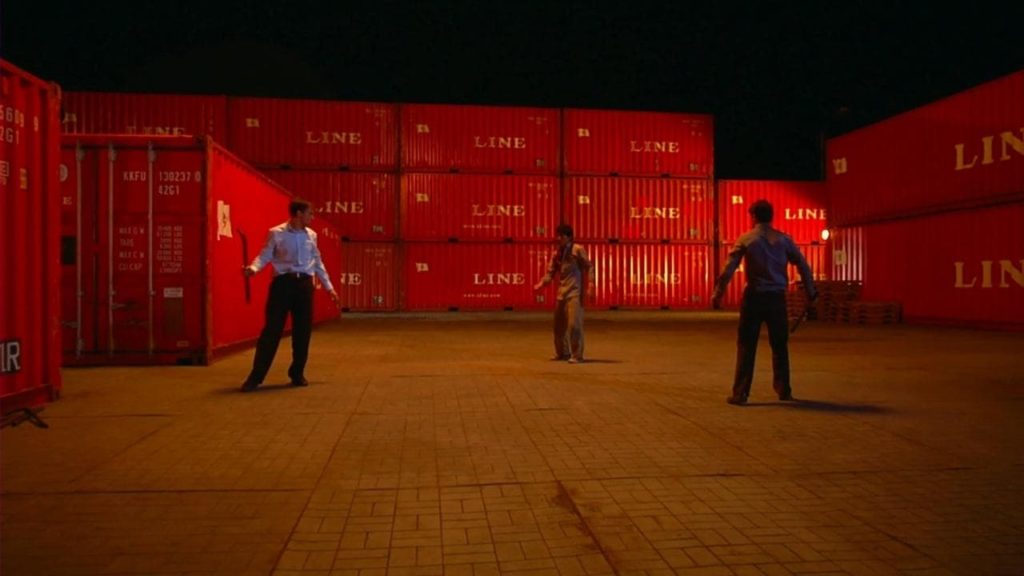
Partnering with producer Ario Sagantoro, now under the fascia of Merantau Films, Evans assembled a production for Merantau on a completely different order of magnitude to anything he’d previously helmed. Watching his films in order for a retrospective, like I’m doing, that’s the first thing that jumps out at you after Footsteps: My God, This is, Like, a Real Film. The cinematography is crisp and professional, executed with access to things like jibs and dollies and Steadicams. Locations include bespoke interiors designed to purpose across multiple studio sets in Jakarta. They cordoned off roads for exterior scenes set in the city, and transported their cast and crew hundreds of miles for the scenes set in West Sumatra. You’d never mistake Merantau for a megabudget blockbuster, but it is unambiguously a film made on an industrial level; the investment that goes into making a movie like this comes out of business bank accounts, not personal ones.
…that’s the first thing that jumps out at you after Footsteps: My God, This is, Like, a Real Film.
In his interview with Scott Adkins for The Art of Action, Evans talks about the butterflies he experienced during production, having moved from shooting a film with five crew members to one with over a hundred. If he was feeling impostor syndrome on-set, then it absolutely doesn’t manifest in the final product. Merantau is a remarkably confident, self-assured object, with a coherent sense of its own style, and some straight up audacious moments of technical prowess. It’s obvious from the first minutes watching it that it differentiates itself from the kind of junky DTDVD action B-movies that it was originally marketed alongside in 2009.
Admittedly, one thing that doesn’t differentiate it is its story. Iko Uwais plays Yuda, a young Minangkabau man setting out on merantau from his rural village to Jakarta. He runs into obstacles; he struggles to find work or a place to live, and his ambitions to teach silat are met with bemusement and discouragement. He’s almost prepared to throw in the towel and return home, when his paths cross with Adit (Yusuf Aulia), a preadolescent pickpocket, and his older sister Astri (Sisca Jessica), a down-on-her-luck dancer in danger of being sold into sex slavery. Yuda draws on his prowess in silat to fight off Astri’s kidnappers, but in so doing wounds the pride of Ratger (Mads Koudal), the violent, theatrically sociopathic gang boss who makes it a point of principle to reclaim Astri and kill Yuda, and turns the city inside out to do it.
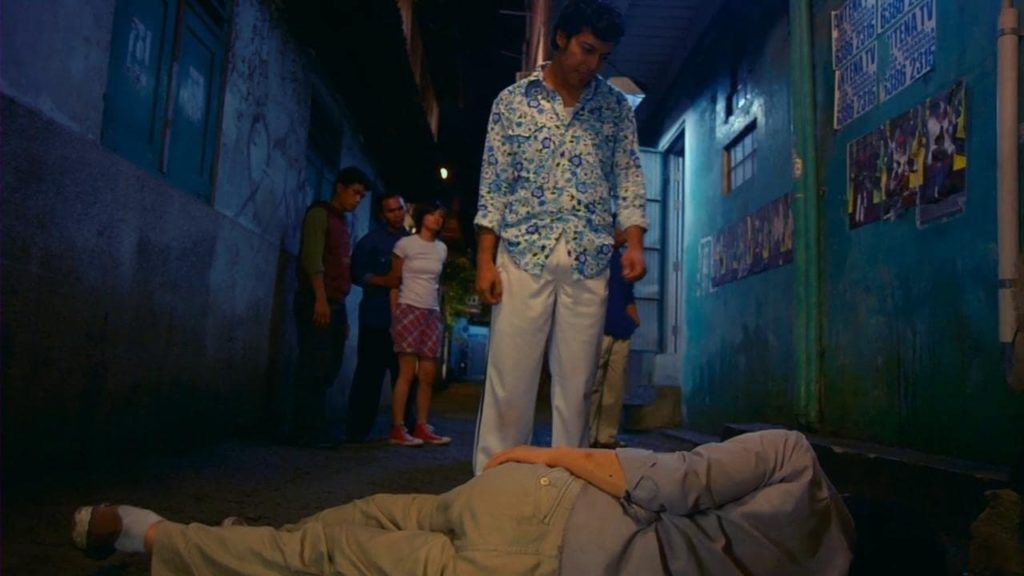
Perfectly solid, unremarkable genre boilerplate, basically; the kind of stock scenario that’s been fuelling action thrillers for decades. To address the elephant in the room (and that’s a turn of phrase I’m using advisedly), Merantau owes a considerable debt specifically to 2003’s Ong-Bak, and to a lesser extent, 2005’s Tom Yum Goong. The beats of the plot are plain to see: a young naïf from the sticks of a Southeast Asian country travels to the big city on a quest; he partners up with a streetwise, cash-strapped male-female duo who share a non-romantic relationship; he earns the wrath of a foreign gang leader and has to fight off wave after wave of gang henchmen in a series of escalating set-pieces across multiple locations. Beyond that, specific action beats like the mid-film foot-chase, or the single-take fight through the floor of a nightclub definitely feel like they’re, maybe not quite copying Prachya Pinkaew’s notes, but at least taking a cheeky peek over his shoulder during a quiz. Uwais’s look in this movie even seems to have been styled after Tony Jaa’s in Ong-Bak – similar loose-fitting, light-coloured clothes, similar floppy haircut and baby-faced, clean-shaven profile.
To be fair, this isn’t something Merantau’s creators are coy about. Gareth Evans specifically cites Ong-Bak in a behind-the-scenes interview, stating that he wants to make an action movie that does for Pencak silat what that film did for Muay Thai. In the action-movie ecosystem these films share, a story’s content is vastly less important than its execution, and in the execution, Merantau is quite a different animal from the Thai films that were all the rage among action movie lovers in the aughts. It’s a good deal less hyperbolic or cartoonish; darker, more sombre, and more po-faced. Uwais is presented as a preternaturally gifted hero, someone capable of dismantling an international human trafficking ring by kicking it proficiently enough, but the action design emphasises him as an underdog; notable more for his scrappy ingenuity and his resilience than his superhuman prowess. He’s emotionally and physically vulnerable to an extent Jaa was never presented as, and that vulnerability is confirmed in a big way when he abruptly and shockingly dies at the end, after defeating the villains and freeing their victims.
Evans specifically cites Ong-Bak in a behind the scenes interview, stating that he wants to make an action movie that does for Pencak silat what that film did for Muay Thai
Looking back on it now, Merantau is an outlier in Evans’ filmography; it’s by far the most sentimental, most earnest thing he’s ever put his name to, a melodrama of unambiguous good set against unambiguous evil, its hero a saintly idealist who’s too pure for this sinful world. Truthfully, a lot of the storytelling in Merantau skews a bit too maudlin and sappy for my taste, the pro-forma genre elements being pitched with gravitas and self-seriousness they don’t really warrant. It takes a while to get going, too – the main conflict doesn’t kick in for the better part of half an hour, and on this rewatch, I was pretty checked-out through the early scenes detailing Yuda’s life back home as a tomato farmer.

Part of this, I take no pleasure in saying, is on account of Iko Uwais’s performance. It’s not something the then-26-year-old can reasonably be blamed for. Together with Yayan Ruhian, Uwais was one of the silat practitioners who Evans met while making the documentary that took him to Indonesia in the first place. At the time, he was working a day job as a driver for a telecom company, with neither acting experience nor any particular aspirations to become an actor; nevertheless, Evans saw something in Uwais that convinced him the young Jakartan should be a film star, and convinced him to join up with the production of Merantau, despite hesitancy on Uwais’s part. In the long run, Evans’ instincts would prove right; in later roles, Uwais would grow more relaxed with being a film star, becoming less self-conscious in front of the camera. In Merantau, he’s still visibly green around the gills. It’s not hard to understand why Evans wanted him for the part; he’s a living dynamo in the action scenes, and he has the kind of wiry physique combined with a handsome, boyish face that makes him ideal as a martial-arts-hero-as-naïf. But he’s visibly stiff and ill-at-ease during the drama scenes in a way that undercuts the poignancy of Yuda leaving home; he makes a lot of gestures for the camera that feel rehearsed and posed and overly directed; you can almost feel Evans repositioning his limbs from shot to shot. This is going to sound like an insanely petty criticism, but here goes: the way he walks bugs me. He sort of loosely flings his legs ahead of himself, keeping his shoulders level and stiff, but exaggeratedly swinging his arms below the elbow. It does not look like the gait of a master martial artist.
There are a few grace notes of character writing that do add a bit of texture and nuance to a cast full of stock types. I really like Yuda’s first meeting with Astri, where he manhandles the scummy club manager (Alex Abbad) trying to extort her out of her tips, only for her to round on him when his white-knight act costs her her job. It’s a moment that casts the hero’s naivete in more of an ambivalent light, showing how Yuda’s lack of worldliness is potentially harmful, not just to himself but to others. I like the dynamic he shares with Eric (Yayan Ruhian), an older man who left home on merantau and fell into a life of crime when he couldn’t make ends meet, (though this plotline is compromised in the version released outside Indonesia; more on that in the footnote at the bottom).*
And I enjoy the villain. Mads Koudal is the sole member of the cast who’d worked with Evans before. He made a compellingly watchable sociopath in Footsteps, his performance really the one thing that gave that film any verve – and apparently Evans agrees, because in his performance of Ratger, Koudal doubles down on everything that made that earlier performance tick; even in his calmest moments, he projects an obviously false bonhomie, every word laced with implicit or explicit threats against those he considers beneath him. When he erupts into screaming fits of rage and violence, it plays like a dam bursting through the flimsiest veneer of civility. It’s a two-dimensional characterisation, without a doubt, but magnetic to look at in a way that most arbitrary mob-boss baddies in action movies aren’t; he’s convincing as a grown toddler throwing a tantrum, persuasively the kind of person who’d pursue an irrational vendetta out of sheer spite and injured pride. One particularly evocative image early in the movie finds him sitting in his penthouse, where he has a series of alcoves set along one wall; in each alcove, a woman stands motionless, primed next to a pole. He points a remote at the alcoves in turn, where lights and music start to play; as each alcove is “activated,” so too is the woman inside, who begins to dance on cue. It’s a creatively monstrous visual; living female bodies reduced to high-tech furniture, a distillation of misogyny to its most unembarrassed, unrepentant essence.

(One caveat though; the characterisation of Ratger as a misogynist eventually leads into legitimately uncomfortable territory. No sugar-coating it – in the third act, after Astri is separated from Yuda and Adit, Ratger’s goons recapture her and bring her to his penthouse, where he rapes her. This plot development, thankfully, is remanded off-screen, and only alluded to euphemistically after the fact, but it’s still tasteless and unnecessary. Having “sex trafficking” be the wrong that the film’s hero must set right is all well and good when it remains a nebulous, one-size-fits-all injustice with the world; that’s genre storytelling working as intended. Having a main character actually be sexually violated as a plot point, though, makes things a degree too real, invoking deep, lingering traumas that a film about kicking evil into submission isn’t equipped to grapple with; it renders Astri’s suffering as a footnote to Yuda’s quest for self-actualisation. There are things you shouldn’t write into your movie unless you’re prepared to make the movie be about them; rape is one such thing.)
Merantau as a drama, then, is a bit clumsy. Very sincere; heart’s in the right place; has a robust structure, and moments where it gives its characters and its themes a surprising amount of specificity. On the other hand, it’s sluggishly paced at the start, oversteps on some sensitive subject matter, and ultimately boils down to an archetypal hero’s-quest narrative that probably would have benefitted from a lighter touch. Shows potential, but room for improvement. C+.
Merantau as an action movie though? Well, that’s a whole other conversation.
It takes a while for Merantau to start up. The early scenes in Sumatra include a couple of silat performances, and there’s a brief chase-sequence through an alleyway once Yuda arrives in Jakarta (Adit steals his wallet). The first, real, honest-to-God fight, involving characters earnestly trying to hurt one another, doesn’t arrive until the film’s 36th minute – fully a third of the way into its runtime. But, after this long, long wind up, the remaining hour of the movie is nothing but the sweet, glorious release of built-up torque. One set-piece follows the next with scarcely a moment to catch a breath in-between, none of which are less than good, and some of which can stand shoulder-to-shoulder with the best set-pieces of the action renaissance of the 2010s.
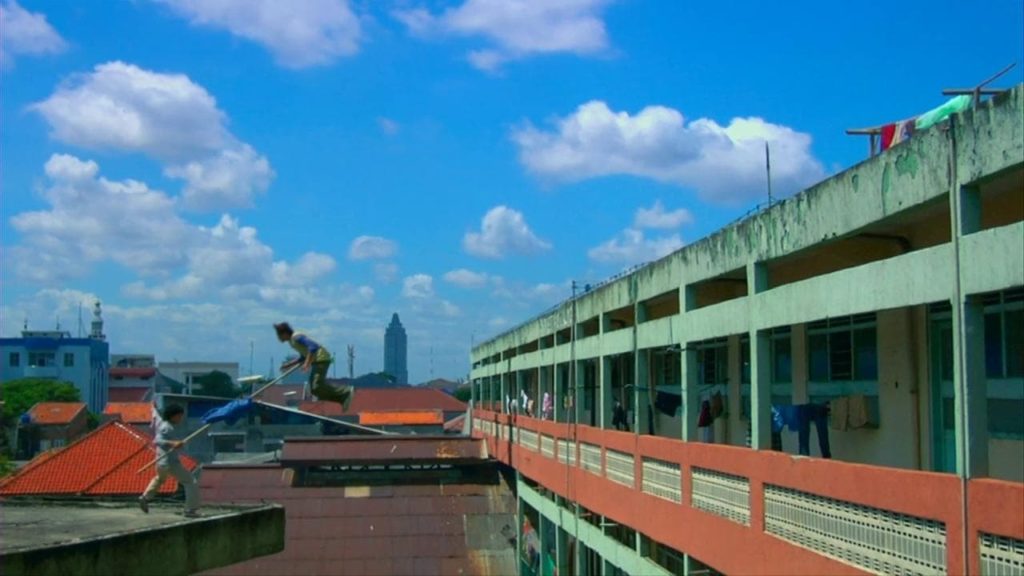
In designing the action for Merantau, Evans and his team consulted closely with silat master Edwel Datuk Rajo Gampo Alam (who has a brief cameo in the film itself, as Yuda’s instructor), with input from Uwais. The partnership, by all accounts, was convivial and mutually respectful; Evans was coming to the film as a white guy who had seen a lot of martial arts films, who knew the rhythms and beats he wanted his fight scenes to hit; Alam was coming as an expert silat practitioner who knew the forms and stances and techniques (specifically of Silat Harimau, a subset of Pencak silat particular to West Sumatra and the Minangkabau in particular, with movements intended to resemble those of a tiger). The partnership proved effective; Merantau works both as an action thriller, and as a exhibition of Silat Harimau.
Indeed, both work to supplement the other. I have some experience with martial arts (way back when I was a teenager; ITF Taekwondo, specifically, and I was never very diligent or good at it), but I don’t have the technical vocabulary to describe exactly what Uwais and his stuntmen are doing here. I’ll give it a go, all the same; Uwais generally keeps to a wide stance, with a low centre of gravity, swinging his arms in wide, gyroscopic motions to maximise crowd control. He often moves to get inside his opponent’s guard, hitting at exposed joints, and throwing knee-strikes into the abdomen. He mixes these close-range strikes up with high-kicks, throws, and locks where appropriate, and on the whole, his techniques seem rooted in fluid, circular movement.
There are no excessively fancy jumping or spinning or flipping techniques, cementing Merantau as taking place in a reality a half-step more grounded than its Thai contemporaries. Nevertheless, the intricate choreography is hypnotic to watch as it unfolds; as in the best martial arts films, it has a musicality to it, suggesting a dance as much as a fight, even as the performers sell the hits like they’re breaking ribs or wrenching ligaments. Moreover, every technique feels motivated; Uwais isn’t just depicted as strong, fast, and agile, but also wily and quick-thinking, reacting to the enemies who outnumber him and proactively finding ways to counter them, scanning the environment for props he can exploit, generally thinking two moves ahead. Every fight is telling a story; not just an undifferentiated flurry of punches and kicks, but a self-contained micro-narrative, introducing new challenges to overcome and problems to solve for its hero on a second-to-second basis. The only real problem with the action I’d point to is a use of speed-ramping that occasionally oversteps its bounds. I’ve no problem with fight movies using skipped frames to sell hits landing, but there are moments here, particularly in the final fight in the shipping yard, where the film will seemingly accelerate to fast-motion for a second or so at a time, and it’s headache-inducing whenever it happens.
Every fight is telling a story; not just an undifferentiated flurry of punches and kicks, but a self-contained micro-narrative
Each scene is punctuated with memorable flourishes and finishing moves, calling upon Evans’ penchant for creative brutality to thrilling effect. Highlights include Yuda’s first encounter with Ratger, where he kicks a glass bottle into the villain’s face and gives him the distinctive scars he wears for the rest of the film, and a “miniboss” fight with a motorcyclist which sees Yuda on the back foot, right up until he grabs a sheet from a bystander carrying laundry and stetches it across the width of the alley, clotheslining his pursuer right out of his saddle.
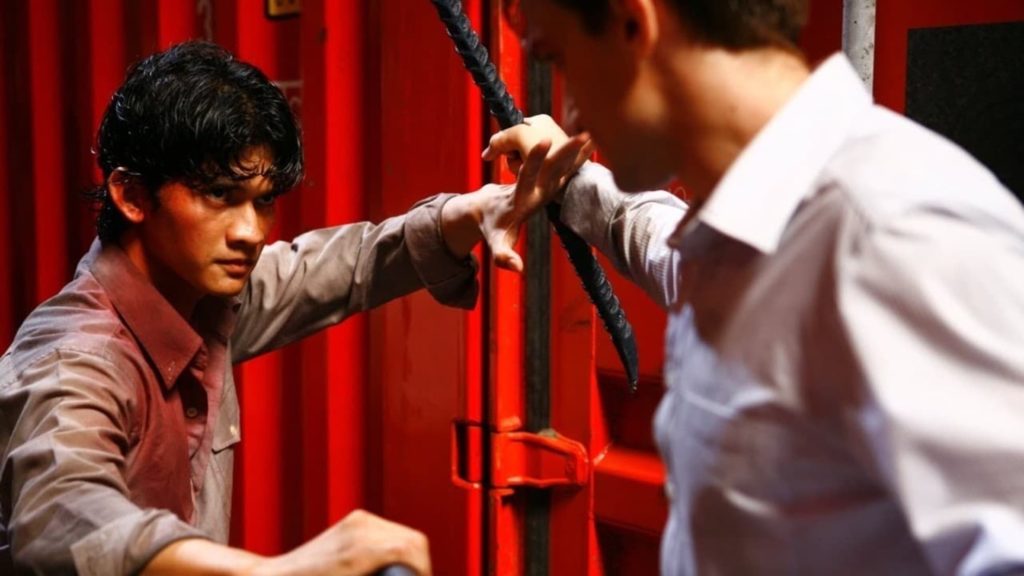
Speaking of “clotheslining,” I’d be remiss not to mention Merantau’s big centrepiece stunt, its party piece that its trailers use to sell it. During a mid-film footchase, Yuda leaps from one rooftop to another; one of the goons chasing him jumps after him. While the goon is still in mid-air, Yuda grabs a bamboo clothes-pole and thrusts it right into the pursuer’s solar-plexus, arresting his momentum in the gap between buildings. The camera follows the goon all the way down his four-storey fall until he lands in the street beneath on his upper back, his aggrieved expression fully visible the whole time. When you watch the sequence back, knowing how the stunt was safely accomplished, you can piece together the edits and back-engineer how it was done; but in the moment, your hindbrain kicks in and for half a second, you’re convinced that “Holy shit, this is a snuff film. They straight up murdered a stuntman, and showed it to us.” This is a full-blown, no-two-ways-about-it, God-tier moment of action design, worthy of being displayed next to anything made by George Miller.
Not all of Merantau is operating at that level, but it is, throughout, a film that’s punching well above its weight class. This is an action movie elevated by commitment to, and belief in, its pro-forma genre elements, to say nothing of its creators’ perfectionism. Evans persistently stresses the importance of pre-visualisation in everything he makes, all his performers having rehearsed and refined their fight sequences over weeks or months of prep in the gym, during which he would work out the optimal camera angles to film from, and how to knit them together to best emphasise impact, and the narrative continuity from one shot to the next. The crew would head in to principal photography with a clear, vividly defined blueprint for how the finished product ought to look, and that blueprint would be realised with fastidious zeal. One anecdote that emerged from the shoot was the story of a single-take fight sequence – Yuda beating his way through the nightclub at the start of the third act, a shot lasting a total of sixty-eight seconds – which required fifty-six takes to get right. An entire, sixteen-hour shift, filming from 10 am until 2 am, was taken to ensure this one sequence met with the borderline-Kubrickian standards being set.
The fastidiousness paid off; Merantau is an action film that doesn’t look like other action films. Evans says he studied the work of Hong Kong greats like Sammo Hung and Jackie Chan to provide the template for his visual grammar, but while the DNA of 80’s HK cinema is in there, Merantau never feels like a faded Xerox of Police Story or Millionaires’ Express or In the Line of Duty 4. Its roving, calculated long-takes give it a character all its own. Fight scenes are captured in uncommonly long takes, the performers’ bodies frames in long-shots encompassing everything from the soles of their feet to the crowns of their heads. Merantau was shot using Panasonic HPX500 cameras; a shoulder-mounted model generally intended for broadcast, not feature-film production. With these making handheld photography unwieldy and impractical, a plurality of the shots in Merantau were done with cameras mounted on dollies or jibs; throughout the movie, the camera has a kind of lithe, muscular presence to it, hovering with the steady smoothness we associate with Steadicam, but with a certain sense of mass, needing to accelerate and decelerate when it pans or tilts.

It’s not just during the fight scenes that it’s a stylish, distinctive-looking movie; Merantau is replete with dynamic, interesting camera moves. When Yuda jumps a fence to the closed building site where he plans to spend the night, the camera follows, starting from an angled overhead crane shot, down to an angle from below waist-level in almost Raimi-esque pursuit, emphasising how conspicuous our hero feels trespassing for the first time. When Adit sharply round a corner in the alleyway chase, with Yuda in pursuit, the camera shows the action from a top-down perspective, snapping ninety degrees clockwise in concert with Adit, framing him like a rat in a maze, emphasising the boy’s unthinking, adrenalised survival instinct. When Yuda is knocked down in his first fight with Ratger’s men, and forces himself to get back to his feet, the camera slowly turns from prone to upright with his motion, reinforcing his determination and single-mindedness.
In general, DP Matt Flannery enjoys angling his camera; he enjoys pivoting and tilting and pushing and panning, and if he can do it in line with orthogonal angles, so much the better. His manoeuvres can be showy, but they’re never gratuitous, always motivated by what will give a scene an extra punch. And almost as much as camera moves, Flannery loves colours that pop. Merantau’s photography also has a particular look to it; low contrast, but high brightness and saturation, frequently combined with soft focus. There’s a washy, neon-ish quality to its images throughout, and never more pronounced than in the climactic scenes, set in a shipping yard against a backdrop of shipping containers. The containers are all so eye-burstingly cherry-red that the colour seems to bleed outside the outlines of the objects being filmed. It gives the whole movie a sense of being set in a heightened, illustrated reality; not so much a comic-book as a fairy-tale. Which, considering its hero-rescues-damsel-from-dragon plotting, I guess Merantau kind of is?
It’s a film that exists at a weird sort of a crossroads; in some ways, it’s generic and simplistic; in others, it’s singular and complex. It’s unabashedly a genre film, but made by someone with an uncommonly refined and interrogative relationship with its genre; someone who broke down that genre to its constituents, and recombined them in a new configuration, recognisable but recognisably different. For all its faults, for all the ways it’s baggy and superficial as a human story, Merantau remains a special accomplishment; an entry into the canon of martial arts cinema that, for all its conventionality, feels like the product of a unique set of circumstances that couldn’t be replicated. Gareth Evans demonstrated his instinct as a visual storyteller in Footsteps; in Merantau, he found a genre to catalyse those instincts.
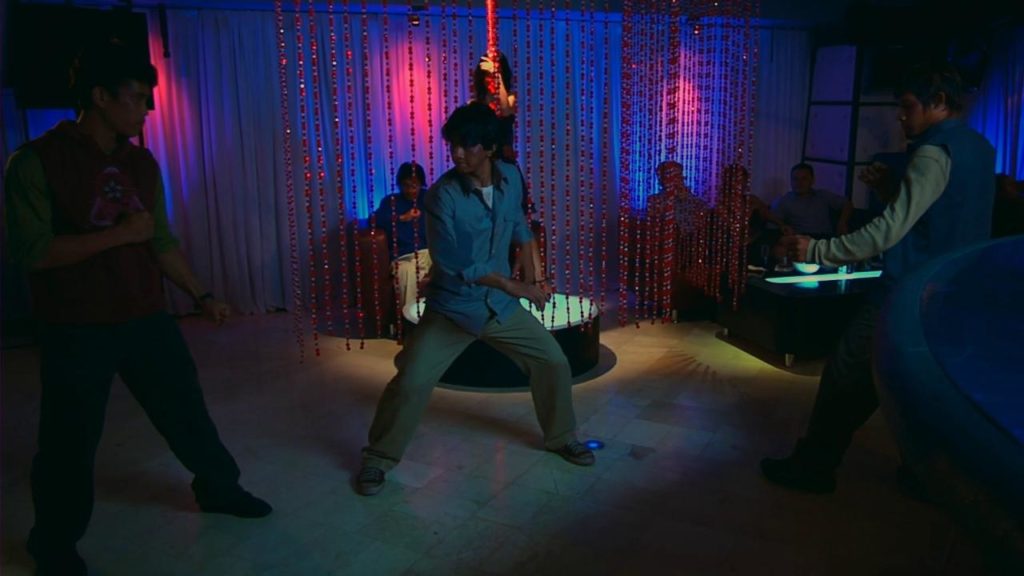
This film is remembered as a footnote now, a steppingstone that would lead its director and star to greater things. And while Evans and Uwais absolutely would go on to surpass Merantau, their first effort together deserves to be acknowledged on its own terms. Even if The Raid and everything that followed had never come to pass, this is a noble, noteworthy object, on its own terms.
[Merantau] is remembered as a footnote now, a steppingstone that would lead its director and star to greater things.
*(One important bit of housekeeping; this review is based on the International Cut of Merantau available to audiences outside of Indonesia. My copy, the PAL DVD released in the United Kingdom by E1 Entertainment in 2009 under the modified title Merantau Warrior, runs 107 minutes long. This is a substantial reduction from the Indonesian Cut, which runs to 134 minutes. I’ve never seen the Indonesian Cut, and to the best of my awareness it’s never been officially released outside its home country, not even in versions like Tiberius Film’s German release Merantau – Meister des Silat, that advertise themselves as “Uncut”. E1’s disc includes a couple of deleted scenes; one of Adit covertly helping Astri with her maths homework that adds a bit of texture to their characterisations, and one that slightly expands on a scene at the start of the third act where Ratger and Luc carry Astri’s unconscious body out of their penthouse apartment. They add up to about five minutes and don’t account for the discrepancy in runtimes between the different cuts.
As to what is in the Indonesian Cut that we didn’t get to see, from what I’ve been able to glean online, there are a few scenes detailing Yuda’s life in Sumatra and his relationship with his brother; a scene where he explains the philosophy of Silat to Adit; and, most crucially, the “job interview” scene, where Yuda goes with Eric to an underground fighting ring where fighters are being tested to become elite mob enforcers. You can find this scene on Youtube, and if you’re a fan of Merantau, you should. It’s a good scene; not only does it feature one of the film’s most virtuosic pieces of action design, a single-take sequence where the camera revolves 360 degrees around Yayan Ruhian utterly dismantling an opponent twice his size, it also adds a lot of weight to Yuda and Eric’s relationship, firmly establishing Eric as Yuda’s dark reflection, a vision of the person he might become if he lets himself be morally compromised for the need for money on his merantau. In the International Cut, their battle in the elevator doesn’t really land thematically; as far as international audiences are concerned, Eric is just some rando Yuda sat next to on a bus for a few hours, not someone he shares any particular bond with. The elevator fight and its outcome don’t earn any of the tragic, good-men-on-both-sides weight that the “job interview” scene would have conferred.
Having said that, I think the changes made to the International Cut were probably judicious, on balance. The single biggest problem with Merantau, even in its 107-minute form, is that it takes far too long to get to the good stuff. If anything, it sounds like the grind of the early scenes is even more exacerbated in the Indonesian version.

Still – and this is why I’m belabouring this footnote so much – it feels kind of insidious to me that distributors have this kind of unilateral power over access to foreign films. It wasn’t until years after I’d seen Merantau the first time that I even realised an alternate cut existed. This is a film that has cultural ambassadorship as part of its mission statement; is it not just a little bit perverse that the version available to Indonesian audiences is buried from view to everyone else with a sincere interest in a globally underexposed culture? Irrespective of which cut is the more functional action movie, to be able to remove 27 minutes of footage, without even being obliged to disclose that’s what you’ve done, doesn’t feel conducive to the flourishing and propagation of art across national and linguistic boundaries.
It’s almost like the profit motive works more to alienate and stratify people than it does to bring them together… but, oh shit, this review of a fun movie about kicking from 14 years ago is in danger of getting political. I’ll stop now.)
- Review Series: Gareth Evans
Is It Good?
Very Good (6/8)
Andrew is a 2012 graduate of the University of Dundee, with an MA in English and Politics. He spent a lot of time at Uni watching decadently nerdy movies with his pals, and decided that would be his identity moving forward. He awards an extra point on The Goods ranking scale to any film featuring robots or martial arts. He also dabbles in writing fiction, which is assuredly lousy with robots and martial arts.

